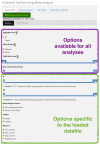Breathing Life Into Meta-Analytic Methods
- PMID: 39072210
- PMCID: PMC11276543
- DOI: 10.5334/joc.389
Breathing Life Into Meta-Analytic Methods
Abstract
Meta-analyses have become indispensable in the behavioral sciences, combining and summarizing data from multiple studies. While they offer many advantages (e.g., increased power, higher generality, and resolving conflicting findings), they currently only provide a snapshot at a given point. In active research areas, frequent meta-analytic updates are necessary to incorporate new evidence. We propose guidelines for live, dynamic meta-analyses and introduce an accessible tool using the R environment. Our app, powered by the Shiny package, enables the meta-analyst to integrate evidence interactively as an update of an existing meta-analysis or from scratch (i.e., a new meta-analysis). By embracing dynamic meta-analyses and leveraging modern tools, researchers can ensure up-to-date meta-analyses in their respective fields.
Keywords: Bayesian statistics; app; meta-analysis; meta-analysis updating.
Copyright: © 2024 The Author(s).
Conflict of interest statement
The authors have no competing interests to declare.
Figures












References
-
- Aksayli N. D., Sala, G., & Gobet, F. (2019). The cognitive and academic benefits of Cogmed: A meta-analysis. Educational Research Review, 27, 229–243. DOI: 10.1016/j.edurev.2019.04.003 - DOI
-
- Allotey, J., Fernandez, S., Bonet, M., Stallings, E., Yap, M., Kew, T., … & Thangaratinam, S. (2020). Clinical manifestations, risk factors, and maternal and perinatal outcomes of coronavirus disease 2019 in pregnancy: living systematic review and meta-analysis. bmj, 370. DOI: 10.1136/bmj.m3320 - DOI - PMC - PubMed
-
- Borenstein, M., Hedges, L. V., Higgins, J. P., & Rothstein, H. R. (2009). Introduction to meta-analysis. John Wiley & Sons. DOI: 10.1002/9780470743386 - DOI
-
- Bornmann, L., Haunschild, R., & Mutz, R. (2021). Growth rates of modern science: A latent piecewise growth curve approach to model publication numbers from established and new literature databases. Humanities and Social Sciences Communications, 8(1), 1–15. DOI: 10.1057/s41599-021-00903-w - DOI - PubMed
LinkOut - more resources
Full Text Sources

